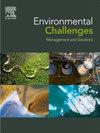Catalytic CO2 fixation in microalgae Arthrospira platensis using direct flue gas
Q2 Environmental Science
引用次数: 0
Abstract
Greenhouse gas (GHG) emissions, particularly CO2, pose a significant threat to climate regulation and the sustainability of human habitats. Effective CO2 control mechanisms are essential for addressing these challenges. This study investigated the potential of Arthrospira platensis microalgae for biological CO2 sequestration from industrial emissions. The primary objective is to optimized A. platensis for CO2 absorption and stabilization, while simultaneously producing valuable by-products for industrial applications. The study was employed a mixotrophic culture approach, manipulating the growth medium with sodium hydrogen carbonate, direct CO2 gas injection, and anatase TiO2 as a catalyst. Analyses included measurements of dry weight, pigment content, pH levels, and CO2 flux. The results revealed that sodium hydrogen carbonate effectively replaced dissolved CO2 gas, allowing biological stabilization without the need for baking soda. Furthermore, sunlight utilization promoted the production of high-value by-products such as phycocyanin and fatty acids. This study underscores the potential of A. platensis to enhance carbon sequestration under mixotrophic conditions. It presents a sustainable strategy to CO2 mitigation while generating industrially valuable compounds, thereby contributing to both environmental and economic objectives.
利用直接烟气催化平节螺旋藻对CO2的固定作用
温室气体(GHG)排放,特别是二氧化碳,对气候调节和人类栖息地的可持续性构成重大威胁。有效的二氧化碳控制机制对于应对这些挑战至关重要。本研究探讨了平节螺旋藻微藻在生物封存工业排放二氧化碳方面的潜力。主要目标是优化白杨对二氧化碳的吸收和稳定,同时为工业应用生产有价值的副产品。本研究采用混合营养培养方法,以碳酸氢钠、直接注气CO2和锐钛矿TiO2为催化剂操纵培养基。分析包括测量干重、色素含量、pH值和二氧化碳通量。结果表明,碳酸氢钠有效地取代了溶解的二氧化碳气体,无需小苏打即可实现生物稳定。此外,阳光的利用促进了高价值副产品如藻蓝蛋白和脂肪酸的生产。本研究强调了在混合营养条件下,平叶青具有增强固碳能力的潜力。它提出了一项可持续的二氧化碳减排战略,同时产生具有工业价值的化合物,从而有助于实现环境和经济目标。
本文章由计算机程序翻译,如有差异,请以英文原文为准。
求助全文
约1分钟内获得全文
求助全文
来源期刊

Environmental Challenges
Environmental Science-Environmental Engineering
CiteScore
8.00
自引率
0.00%
发文量
249
审稿时长
8 weeks
 求助内容:
求助内容: 应助结果提醒方式:
应助结果提醒方式:


